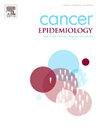Occupational heat exposure and stomach cancer risk in a pooled analysis of two Spanish case-control studies in the stomach cancer pooling project – StoP consortium
IF 2.3
3区 医学
Q3 ONCOLOGY
引用次数: 0
Abstract
Background
Occupational heat stress occurs frequently and is increasing with climate change. Studies of occupational heat exposure and stomach cancer risk are limited. We used data from the international Stomach cancer Pooling (StoP) Project to investigate the relationship between occupational heat exposure and stomach cancer risk in a pooled analysis of two Spanish case-control studies, including 566 stomach cancer cases and 2984 controls.
Methods
The Spanish job-exposure matrix, MatEmEsp, was used to assign heat exposure estimates to participant occupations. We evaluated three exposure indices: ever vs. never exposed, cumulative exposure and duration (years). We calculated odds ratios (ORs) and corresponding 95 % confidence intervals (CIs) using unconditional logistic regression models including terms for potential confounders.
Results
Overall, 60.6 % of cases and 42.7 % of controls were ever occupationally exposed to heat. Occupational heat exposure was associated with a moderately elevated risk of stomach cancer (OR 1.31; 95 % CI 1.05, 1.63) when comparing ever vs. never exposed individuals in both studies combined. Elevated ORs were also observed across categories of cumulative exposure and duration (p-trend = 0.01 and 0.03, respectively). Findings were robust to additional covariate adjustment and in analysis of never smokers. There was no clear evidence for interaction according to exposure status to other suspected occupational stomach carcinogens.
Conclusion
Findings from this study provide some evidence for a positive association between occupational heat exposure and stomach cancer risk. Further research is needed to advance occupational heat assessment tools for epidemiological research as well as studies in more geographically diverse populations.
职业热暴露和胃癌风险在两个西班牙病例对照研究的汇总分析在胃癌汇集项目- StoP联盟。
背景:职业热应激频繁发生,并随着气候变化而增加。职业性热暴露与胃癌风险的研究是有限的。我们使用来自国际胃癌汇总(StoP)项目的数据,对两项西班牙病例对照研究进行汇总分析,调查职业热暴露与胃癌风险之间的关系,其中包括566例胃癌病例和2984例对照。方法:西班牙工作暴露矩阵,MatEmEsp,被用来分配热暴露估计参与者的职业。我们评估了三个暴露指数:曾经与从未暴露,累积暴露和持续时间(年)。我们使用包含潜在混杂因素的无条件逻辑回归模型计算比值比(ORs)和相应的95% %置信区间(CIs)。结果:总体而言,60.6% %的病例和42.7% %的对照组曾经职业暴露于高温。在两项研究中,当比较曾经与从未接触过的个体时,职业性热暴露与胃癌风险适度升高相关(OR 1.31; 95 % CI 1.05, 1.63)。不同类别的累积暴露和持续时间也观察到ORs升高(p-trend分别= 0.01和0.03)。在额外的协变量调整和从不吸烟者的分析中,研究结果是稳健的。根据其他疑似职业性致癌物的暴露状况,没有明确的证据表明两者之间存在相互作用。结论:本研究结果为职业热暴露与胃癌风险之间的正相关提供了一些证据。需要进一步的研究来推动职业热评估工具用于流行病学研究以及更多地理上不同人群的研究。
本文章由计算机程序翻译,如有差异,请以英文原文为准。
求助全文
约1分钟内获得全文
求助全文
来源期刊

Cancer Epidemiology
医学-肿瘤学
CiteScore
4.50
自引率
3.80%
发文量
200
审稿时长
39 days
期刊介绍:
Cancer Epidemiology is dedicated to increasing understanding about cancer causes, prevention and control. The scope of the journal embraces all aspects of cancer epidemiology including:
• Descriptive epidemiology
• Studies of risk factors for disease initiation, development and prognosis
• Screening and early detection
• Prevention and control
• Methodological issues
The journal publishes original research articles (full length and short reports), systematic reviews and meta-analyses, editorials, commentaries and letters to the editor commenting on previously published research.
 求助内容:
求助内容: 应助结果提醒方式:
应助结果提醒方式:


